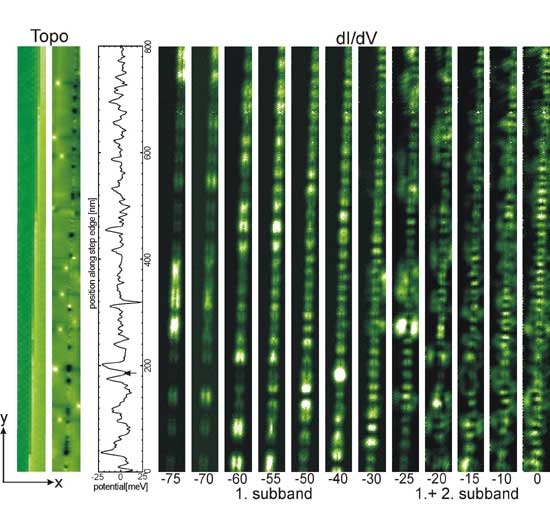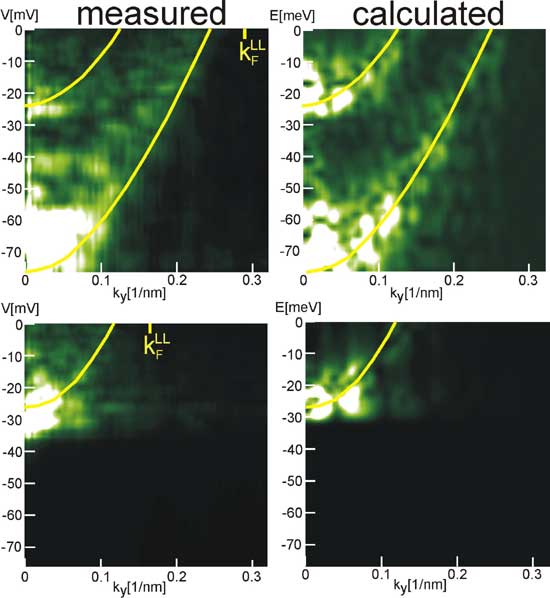| Introduction to STM | Instrumentation | Results / Projects |
| Gallery | Publications | Team |
Recent Results
Scanning tunneling spectroscopy of a 1DES
One-dimensional electron systems (1DES) are particularly interesting since the electron-electron interaction in a 1DES is pathological. Theory predicts that a single-particle description of the system breaks down (at least close to the Fermi level) and many-particle excitations are the only excitations. They are spin and charge density waves with different Fermi velocities. Due to the different velocities, one speaks about spin-charge separation and the system is called a Luttinger liquid to distinguish it from Fermi liquids still described within the single-particle picture.
 |
| Fig. 1: from left to right: first: STM image of a step edge; next: same image after subtracting the average step edge showing the disorder as bright and dark spots; next: resulting disorder potential; remaining: LDOS of the 1DES at different energies as indicated. |
We investigated several 1DESs which are confined below charged step edges One step edge is shown in the left column of Fig. 1. This 1DES exhibits two-subbands, but others exhibit only one subband. The determined subband energies in the displayed case correspond to an average kinetic energy of 20 meV and to an average electron-electron interaction strength of 25 meV within the 1DES. The 1DES is moreover subject to disorder, which has been determined and is shown in he third column of Fig. 1. It exhibits fluctuations of a rms-value of 10 meV. The other columns of Fig. 1 display the measured LDOS at the step edge at different energies. Alignement of the LDOS with the potential disorder can be observed e.g. at the potential valley marked by an arrow, where a bright spot is found at -40 mV (resonant state).
 |
| Fig. 2: left: Fourrier transforms of the measured LDOS of two different 1DES; right: corresponding calculated Fourrier transforms. |
Surprisingly the LDOS could be largely reproduced by a single-particle calculation. This is demonstrated in Fig. 2, where Fourrier transforms representing the k-space distribution of the states are shown for two different step edgese with one and two subbands, respectively. The yellow lines show the expected single-particle dispersion of a not disordered system. Obviously the k-space distribution largely follows the undisturbed dispersion with additional intensity within the parabola. More importantly, the measured k-space distrĂbution is very similar to the calculated one. In particular, the k-value expected for the charge-density wave within the Luttinger model, also indicated, exhibits no intensity. This intriguing result is currently not completely understood, but might be a good starting point for further investigations of the 1DES case.
Related Publications
|
Introduction to STM | Instrumentation | Results / Projects | Gallery | Publications | Team
impressum © copyright 2002 by group R - university of hamburg
